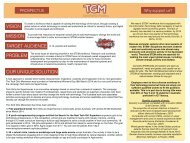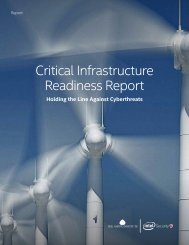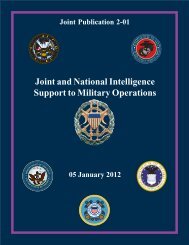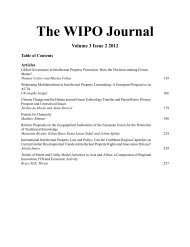Transparency Initiative (EITI)
2eoch1l
2eoch1l
Create successful ePaper yourself
Turn your PDF publications into a flip-book with our unique Google optimized e-Paper software.
89<br />
where transparency can lead to reform. However, the<br />
study could not identify robust methodology in the Validation<br />
process as established in 2016 that would consistently<br />
detect whether there is freedom to debate the<br />
outputs of the <strong>EITI</strong>. In the validation reports of the past,<br />
there has been very little consideration of this, despite<br />
it being a part of the 2011 Rules. The “custodians” of the<br />
Standard, the <strong>EITI</strong> Board and International Secretariat,<br />
can only guarantee the production and assurance<br />
of the Requirements under the <strong>EITI</strong> Standard, which is<br />
done through the Validation process. Unless the Board<br />
integrates items into the standardized <strong>EITI</strong> methodology<br />
and/or the Secretariat includes those in the guidance<br />
notes which interpret the Requirements, countries<br />
can dodge the debate and political consequences, and in<br />
doing so they are able to delink increased transparency<br />
from increased accountability.<br />
19. No overarching ‘transparency and accountability metrics’:<br />
Given the broad range of objectives and institutional<br />
solutions observed, this study found it feasible to<br />
produce a generic results model, but not feasible to develop<br />
a single overarching indicator for <strong>EITI</strong>-induced<br />
systemic sector development or ‘transparency and accountability<br />
metrics’ that cover the diverse set of 50<br />
plus country cases. The <strong>EITI</strong> is implemented by countries<br />
and indicators measuring impact need to fit to the<br />
individual country case of systemic strengthening of<br />
good governance. The theory of change and the generic<br />
<strong>EITI</strong> results model of the study is designed to cover this<br />
demand-driven and flexible approach.<br />
EFFICIENCY<br />
20. Research into its own impact neglected: None of the officially<br />
mandated evaluations and reviews has served<br />
the purpose of producing longitudinal baseline data.<br />
They could have equally been commissioned along<br />
the given questions of interest (e.g. Scanteam 2011 evaluation<br />
informing the strategy reform that led to the<br />
Standard 2013). In that respect, the <strong>EITI</strong> has not used<br />
its resources meaningfully to conduct research into its<br />
own impact.<br />
21. Accountability of remunerations: Country case studies<br />
indicate that remunerations for <strong>EITI</strong> activities and<br />
per diems in lesser developed countries can be out of<br />
balance with poverty or income levels in those countries.<br />
They may, however, be in balance with the level<br />
of internationally funded activities in the respective<br />
country, unrelated to <strong>EITI</strong>-specific conditions. The <strong>EITI</strong><br />
has no rules against this but encourages accountability<br />
through the Board (Rich/Moberg 2015: 110). The review<br />
of literature and documents did not produce a full picture<br />
of modes of delivery, allocation of budgets and aspects<br />
of cost-efficiency – and neither did the interviews.<br />
This impedes a fair and sound assessment of the efficiency<br />
of the <strong>EITI</strong>.<br />
SUSTAINABILITY<br />
22. Consensus to make transparency meaningful for the<br />
target groups: The <strong>EITI</strong> is unified in the approach to<br />
make transparency meaningful for the target groups<br />
(e.g. Progress Report 2016 – From Reports to Results). It<br />
has been widely ascertained by stakeholders that more<br />
of the same (publishing reports that remain largely unread<br />
by the target audience in some countries) does not<br />
lead to better results and can at a certain point be an<br />
impediment to impact and sustainability.<br />
23. Decisions by consensus, not sufficiently based on evidence:<br />
The question of whether the 2013 Standard is<br />
sustainable is a critical one. By heavily engaging the EI-<br />
TI in routine operations at country level implementation,<br />
it became less of an ‘initiative’ and more of an ‘organization’.<br />
An extensive strategy review was conducted<br />
by the <strong>EITI</strong> prior to the Standard and a governance review<br />
thereafter, but there was no ex-ante evaluation to<br />
provide a systematic basis of evidence before the farreaching<br />
decision to introduce the Standard was taken.<br />
Ex post, an external and independent assessment<br />
came to the conclusion in early 2015 that not a single<br />
one of the <strong>EITI</strong> countries had met all the governance<br />
Requirements of the Standard (MSI Integrity 2015). Given<br />
that not all countries have reported under the Standard,<br />
let alone been validated against it, the bulk of firsttime<br />
Validations will not be completed until the end of<br />
2017 and will likely show results of rather weak national<br />
M&E systems. Furthermore, officially mandated evaluations<br />
of the <strong>Initiative</strong> have not been applied, which<br />
could be of use to guide decisions.<br />
24. The <strong>Initiative</strong> holds a key to change the governance dimension:<br />
Regarding the dimensions of economic, social<br />
and environmental sustainability, the <strong>EITI</strong> has the









